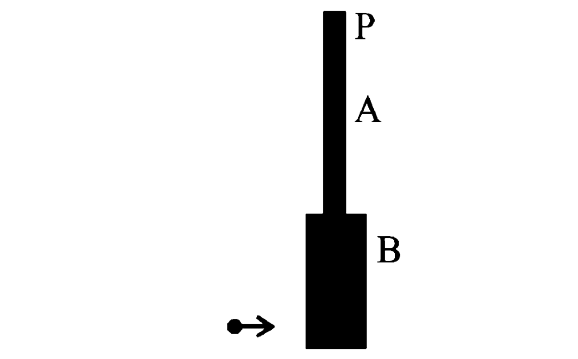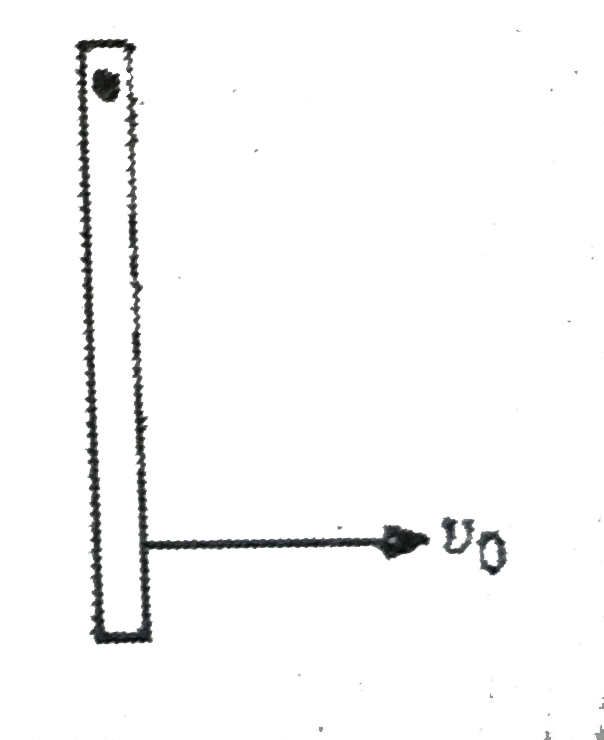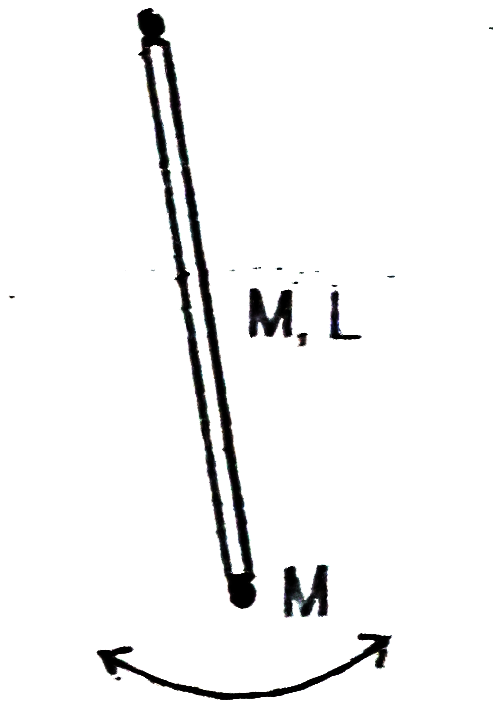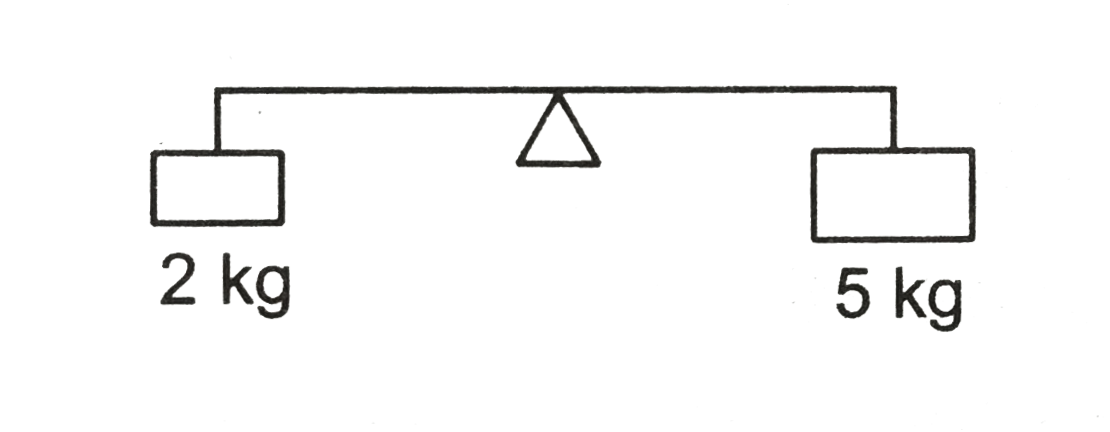Two uniform thin rods A and B of length 0.6 m each and of masses 0.01 kg and 0.02kg respectively are rigidly joined end to end. The combination is pivoted at the lighter end, P as shown in fig. Such that it can freely rotate about point P in a vertical plane. A small object of mass 0.05kg, moving horizontally, hits the lower end of the combination and sticks to it what should be the velocity of the object so that the system could just be reised to the horizontal position.

The correct Answer is:C
During collision, the torque of the system about P will be
zero because the only force acting on the system is through
P(namely weight of rods/mass m/reaction at P)
Given:l=0.6m
m_A 0.01kg<br>m_B = 0.02kg<br>m= 0.05kg<br>sincetau = (dt)/(dt) and tau = 0<br>rArr L is constant.<br><imga≤ocr_imageload∈g=lazysrc=https://d10lpgp6xz60nq.cloudfront.net/physics_images/JMA_RM_C06_068_S01.pngwh=80%mx-autosty≤=background:white;><br>Anga––rmomentumbeforecollision=mvxx2l ..(i)<br>Anga––rmomentumaftercollision=iomega ..(ii)<br>WhereIisthemomentof∈ertiaofthesystemaftercollision<br>aboutPandomegaistheanga––rvelocityofthesystem.M.I. about P:I_1 = M.I. of mass m<br>I_2 = M.I. of rod m_A<br>I_3 = M.I. of rod m_B<br>I=I_1+I_2+I_3<br>=[m(2l)^2 + {m_A((l^2)/(12)) + ((l)/(2))^2} + {m_B((l^2)/(12)) + ((l)/(2)+l)^2}]<br>=[4ml^2 + m_A((l^2)/(12)+(l^2)/(4)) + m_B ((l^2)/(12)+(9l^2)/(4))]<br>=[4ml^2 + (1)/(3)m_Al^2 +(7)/(3)mBl^2] = 0.09kgm^2<br>Frm(i)and(ii)<br>I oemga = mvxx2l<br>rArr omega = (mvxx2l)/(I) =(0.05xxvxx2xx0.6)/(0.09) = 0.67v<br>Apply∈gconservationofmechanicale≠rgyaftercollision.<br>(Usingtheconceptofmass)<br>LossofK.E.=Ga∈∈P.E.<br>(1)/(2)I omega^2 = mg(2l)+m_A((l)/(2))g +m_Bg((3l)/(2))<br>rArr (1)/(2)xx0.09xx(0.67v)^2<br>=[0.05xx2+0.01xx(1)/(2)xx(3)/(2)]xx9.8xx0.6<br>rArr v = 6.3m//s
Related Playlists
- BOOK - SUNIL BATRA (41 YEARS IITJEE PHYSICS)CHAPTER - ROTATIONAL MOTIONEXERCISE - MCQs with one correct answer1videos
ROTATIONAL MOTION
- BOOK - SUNIL BATRA (41 YEARS IITJEE PHYSICS)CHAPTER - MOTIONEXERCISE - JEE Main And Advanced63videos
MOTION
- BOOK - SUNIL BATRA (41 YEARS IITJEE PHYSICS)CHAPTER - SIMPLE HARMONIC MOTIONEXERCISE - JEE Main And Advanced69videos
SIMPLE HARMONIC MOTION
Similar Practice Problems
- Question 1 - Select One
A uniform rod of mass m and length l is hinged at upper end. Rod is free to rotate in vertical plane. A bail of mass m moving horizontally with velocity v0 collides at lower end of rod perpendicular to it and sticks to it. The minimum velocity of the ball such that combined system just completes the vertical circle will be
A2[√2gl]B√2glC2[√gl]D√gl - Question 1 - Select One
A slender rod is hinged at its top end and hanging freely in a vertical position. A tiny ball, moving horizontally, hits the lower end of the rod elastically and comes to rest. The ratio of the mass of rod to the mass of the ball must be
A3:2B3:1C5:3Dinsufficient data - Question 1 - Select One or More
A thin uniform rod is free to rotate about a fixed smooth horizontal axis as shown. A point mass hits horizontally with velocity v0 to the one end B of the rod. When it hits, it sticks to the rod, then :
 AMinimum value of v0 for the rod to rotate by an angle π2is2√gL .BAngular acceleration of the rod when the rod is horizontal is 9g8L .CForce applied by the axis on the rod in the horizontal state is 5mg/6 .Dfor a small velue of v0 the rod performes small oscillations with a period of 43π√lg
AMinimum value of v0 for the rod to rotate by an angle π2is2√gL .BAngular acceleration of the rod when the rod is horizontal is 9g8L .CForce applied by the axis on the rod in the horizontal state is 5mg/6 .Dfor a small velue of v0 the rod performes small oscillations with a period of 43π√lg - Question 1 - Select One
A uniform rod of mass 20 Kg and length 1.6 m is piovted at its end and swings freely in the vertical plane. Angular acceleration of the rod just after the rod is relased from rest in the horizontal position is
 A15g16B17g16C16g15Dg15
A15g16B17g16C16g15Dg15 - Question 1 - Select One or More
A thin uniform rigid rod of length l is hinged at one end so that it can move ina vertical plane by rotating about a horizontal axis through upper end. The lower end is given a sharp blow and made to acquire a linear velocity Maximum height attained by lower end of the rod is:
 Av203g for v0<√6glB3v20g for v0<√6glC2l for v0≥√6glDl for v0=√3gl
Av203g for v0<√6glB3v20g for v0<√6glC2l for v0≥√6glDl for v0=√3gl
Similar Questions
A thin rod of mass 0.9 kg and length 1 m is suspended , at rest form one end so that it can freely oscillate in the vertical plane. A particle of move 0.1 kg moving in a striaght line with velcoity 80 n/s hits the rod at is bottom most point and sticks to it (see figure) . The angluar speed ( in rad/s) of the rod immediately after the collision will be .
 View Solution
View SolutionA uniform rod ofmass M and length L is hanging from its one end free to rotate in a veritcal plane.A small ball of equal mass is attached of the lowe end as shown. Time period of small oscillations of the rod is
 View Solution
View SolutionA thin uniform rigid rod of length L is hinged at one end so that it can move in a vertical plane by rotating about a horizontal axis through upper end. The lower end is given a sharp blow and made to acquire a linear velocityvo . Find the maximum height to which the lower end can rise.
 View Solution
View SolutionA ligh rod of length 1 m is pivoted at its centre and two masses of 5 kg and 2 kg are hung from the ends as shown in the figure. Find the initial angular acceleration of the rod assuming that it was horizontal in the beginning.
 View Solution
View SolutionThe thin rod shown below has mases M and length L. A force F acts at one end as shown and the rod is free to rotate about the other end in horizontal plane. Initial angular acceleration of the rod is :
 View Solution
View Solution

